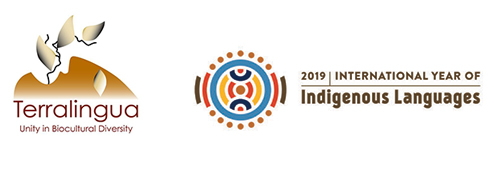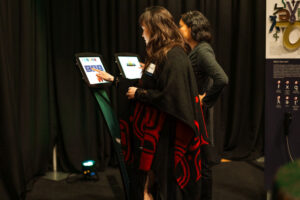by Cristina Zárraga (Yagan, Chile)

Landscape of Bahía Mejillones, Onaašáka (Beagle Channel). Photo: Oliver Vogel, 2014
“I was born in Róbalo, on the 24th of May. And they say, so tells me my aunt, that when I was born during the night, there was a storm from the south. And I was born in an akali. My dad built an akali, and my aunt attended my mom so I would come into the world. They say there was a big storm from the south, with snow, and that night I was born, on the 24th at night . . .”
On the 24th of May, 1928, during a night of ilan tashata (storm from the south), my grandmother Cristina Calderón came into the world in an akali, the traditional Yagan hut. She was delivered by Granny Gertie, the midwife of the old days, in Caleta Róbalo, on the north coast of Navarino Island in Tierra del Fuego, Chile.
Her parents were Akačexaninčis (Juan Calderón) and Lanixweliskipa (Carmen Harban). They belonged to the last generation that went through the Čiaxaus, the Yagan initiation ceremony — the generation that was documented by ethnologist Martin Gusinde between 1918 and 1923.
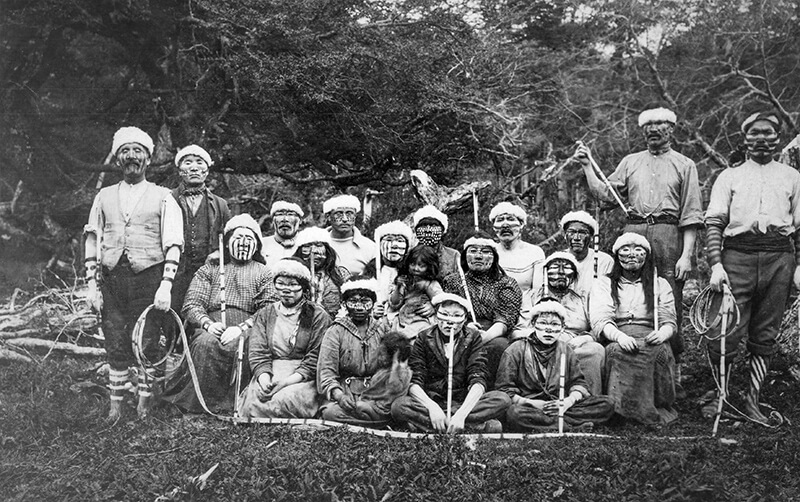
A Čiaxaus initiation ceremony, Bahía Mejillones, 1922. The picture shows among others, Cristina Calderón’s father Akačexaninčis (Juan Calderón), the man standing on the extreme right, and her godmother Gertie, sitting to the right of him. Photo: Martin Gusinde, 1922
Her father Juan Calderón died in 1931 in Mejillones, Navarino Island, and her mother Carmen Harban passed away three years later, in 1934. That set the difficult life path that my grandmother would be bound to follow, orphaned at an early age, and witness to the cultural and material breakdown of our ancestral Yamana culture [Ed.: Yamana is another name for the Yagan culture]. The struggle to survive, first in the face of the overwhelming presence of alcohol, then under the thumb of the Chilean military authorities.
My grandmother would be bound to follow a difficult life path . . . witness to the cultural and material breakdown of our ancestral Yamana culture.
“When my mom died in Mejillones and I was left orphaned, I went to live with my grandfather and Granny Julia, Karpakolikipa . . .”
After losing her parents, my grandmother was left under the tutelage of her grandfather Halnpensh, but he died in a fight that same year, on the 18th of September 1934, having been hit in the stomach by a Spaniard. Following that event, she was taken in by her godmother, Granny Gertie. Living with Gertie’s family, she was also cared for by her uncle Felipe and her cousin Clara.
“My godmother took me away, Granny Gertie did, she took me to her home, and I was crying . . . ‘Stop crying,’ she told me, ‘your grandpa is just fine, Watauinéiwa [God] took him and has him in his presence . . .’ He was a good man, my grandpa, he was never mean.”
Up to the age of nine, by grandmother only spoke Yagan, the language of her parents. She was also learning words and phrases from other dialects, such as that spoken by Granny Julia, Karpakolikipa, who came from the Wollaston Islands (a group of small islands one of which forms Cape Horn, and which was home to one of the five groups of the Yagan people, with its own dialect). In addition, she picked up a little English from Granny Gertie, who, while staying at an Anglican Mission, along with learning to spin and weave, like many Yagan women, also learned English.
“When I was little, I spoke Yagan only. I learned to speak Spanish from a girl, Ema Lawrence, of the Lawrences who were owners of the Róbalo Ranch. I would get together with Ema to play. The first few days I didn’t understand a word, but little by little I started learning the language with her. I would also listen to Chacón, Granny Gertie’s husband, and that’s how I learned Spanish . . .”

House of the Sarmiento family in Bahía Mejillones, Navarino Island. Last remaining house from the times of Cristina Calderón’s childhood in Bahía Mejillones. Photo: Oliver Vogel, 2014
In those days, many young Yagan died from lung disease, and each time fewer and fewer people spoke Yagan. And furthermore, because of discrimination, the mothers would no longer pass the language on to their children. That’s how the language started shrinking rapidly, replaced by Spanish.
Because of discrimination the mothers would no longer pass the language on to their children. That’s how the language started shrinking rapidly, replaced by Spanish.
My grandmother’s life unfolded as that of a nomad, moving from place to place, traveling freely, as her ancestors had done on canoes — except that in her time one traveled by boats with ores and sails. But one could say that people still lived a nomadic life that granted them a certain degree of freedom.
People still lived a nomadic life that granted them a certain degree of freedom.
Summertime, sheep-shearing time. Families would converge on the ranches where they could get sheep-shearing work, such as Remolino and Harberton on the Argentinean side, and Róbalo on Navarino Island, on the Chilean side. Wintertime, back in Mejillones, or off to hunt for otters. In the old days, there were no borders across Onaašáka, the Beagle Channel. My grandmother was able to live at the tail-end of this time of freedom. Today, Onaašáka is divided up between Chile and Argentina.
“While I was living with my grandpa, we would get out on the water, we would go to Punta Lobo [in the east of Navarino Island] to eat guanaco meat [Ed.: guanaco: the wild ancestor of llamas and alpacas], we went island to island looking for birds’ eggs, and that’s what we ate. And so I went, along with my grandpa.”
At age fifteen, her family situation forced her to get married — with a man much older than her, Felipe Garay, perhaps fifty years old. With no other options, Garay was her first partner. Together, they lived in Puerto Eugenia, in the east of Navarino Island. They had three boys, and when she was pregnant with the third one, Felipe became ill and died.
“I didn’t like that, when they told me I had to get together with him. ‘He’s a good man, he’ll take care of you, you’ll have enough to eat, you’ll have clothes, you’ll have everything you need and will be in peace,’ my aunt would tell me. ‘You won’t be going around like your sister and her mate, those two who go for the otters, who go around with no shoes and no clothes.’ There I was, forced to say yes. I was maybe fifteen years old, and I was thinking, “It can’t be!” because he was so much older. “It can’t be!” I would say — but then I would start thinking . . .”
After Garay’s death, it was disenfranchisement all over again, it was poverty — and now with her children in tow. In those days, a woman couldn’t remain alone. That’s when my grandfather Lucho Zárraga came into the picture. He was a Selknam, of the indigenous group from the other side of the channel (now the Argentinean side). He worked at the Harberton Ranch and offered to take her with him to the other side and take care of her.
“Well, when I got together with your grandpa Lucho, we lived in peace in Harberton — how long, how many years . . . I had to go with him, I told him: ‘I have three children and you’re not going to like that . . .’ But he did take care of me, and of the children too, the three little ones, he was like a father to them . . . We stayed in Harberton from 1949 to 1959. Lucho was foreman of the shepherds, and I spent a happy time with him.”
In 1962 Lucho Zárraga died. “Lucho was always coughing and coughing, until he got lung disease . . . He died in hospital in Punta Arenas.”

Cristina Calderón collecting mapi (rushes) for traditional basketry in Caleta Douglas, Navarino Island. Photo: Oliver Vogel, 2015
After my grandfather Lucho’s death, Teodosio Gonzales showed up. My grandmother had known him from the time of her youth. He came from the city of Ushuaia to work on Navarino.
“Which year it was I can’t quite remember, but it had to be around 1964. He came, Teodosio did, he talked to me and, well, that’s how it went . . .”
From then on they lived together until 2009 — her last life companion, whom she somehow chose, for they had been attracted to each other from the days of their youth. But fate had separated them, forging different paths for them, until they finally met again as adults. From this union her only daughter was born.
* * *
This text is a short summary of the biography of my Yagan grandmother, with whom I lived more than ten years, reconnecting with my roots, in the land that my father left one day — and where I set off on a journey toward the past, delving into my ancient Yamana culture.
Today, Cristina Calderón is well known around the world as the last living member of the Yagan or Yamana people of Tierra del Fuego, the last fluent speaker of her native language — she who embodies the direct link with our ancestors, those who experienced ceremonies such as the Čiaxaus, the puberty initiation ceremony, or the kina, a male ritual, or the loima yakamush, the shamanic school. Knowledge and heritage that were handed down from generation to generation until they came to my grandmother, and from her to us.
Today, Cristina Calderón is well known around the world as the last living member of the Yagan or Yamana people of Tierra del Fuego, the last fluent speaker of her native language.
That’s why she cannot be the last of the Yagan. The last of a generation, maybe. But the fact is that there is a vast progeny belonging to this people, which today lives mostly in Ukika, on Navarino Island.
My grandmother cannot be the last of the Yagan. The last of a generation, maybe. But . . . there is a vast progeny belonging to this people.
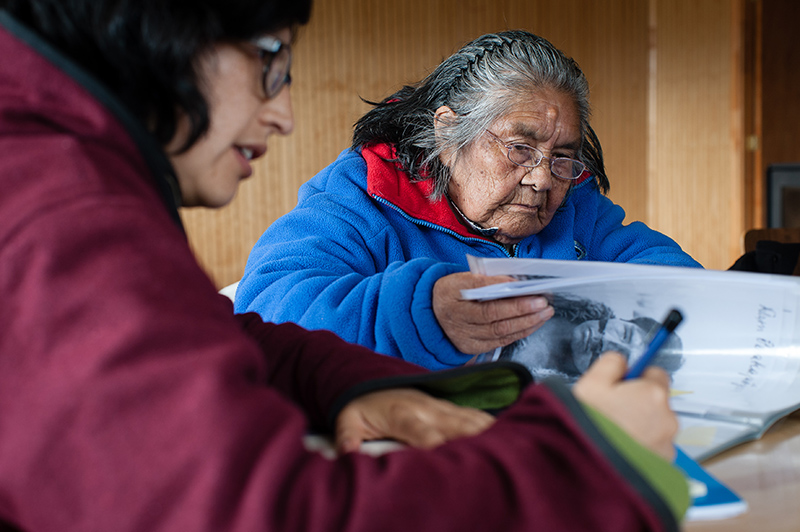
Cristina Zárraga and Cristina Calderón working in Ukika, Navarino Island. Photo: Oliver Vogel, 2014
In hearing the story of my grandmother, the story of her parents, in those days and farther back, we get a palpable sense of the cultural breakdown the Yagan underwent because of the arrival of white people — the gold prospectors, the sea lion hunters, the missionaries, and later the Chileans and Argentineans who appropriated and divided up those lands, which didn’t even belong to them.
Losing their cultural roots, their language, their cultural traditions, and their freedom, being invaded by epidemics and by customs that were utterly foreign to their nature, such as alcohol, all that brought forth the decline and collapse of their culture. Their spiritual strength, which had connected them with nature and with God, rapidly started to wane, and in that way they lost their identity.
Yet today Cristina Calderón, my Yagan grandmother, is the carrier of the ancestral voices that belong to the collective soul of this ancient race. Her memory and her language infuse us with that original strength, from those remote times at this southernmost tip of the earth. Today, she transmits her knowledge, her wisdom, her memories, and her language to those who are closest to her, as well as to those others who are interested in this culture and seek her out.
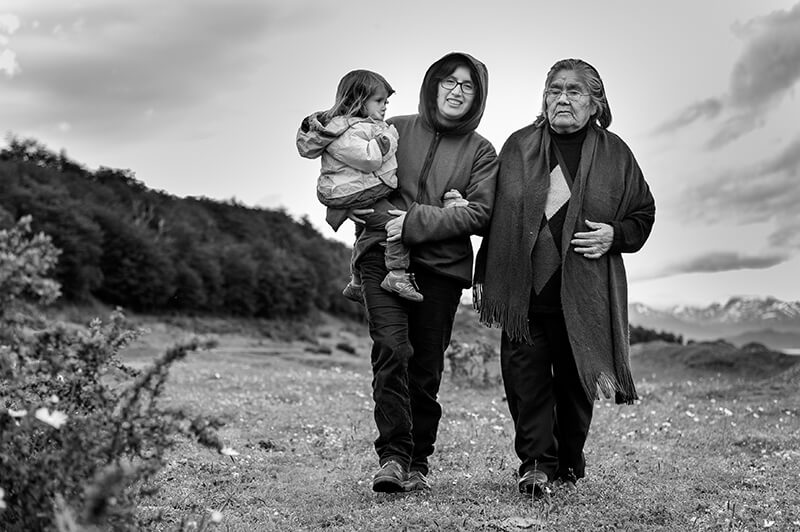
Grandmother, granddaughter and great-granddaughter in Bahía Mejillones, Navarino Island. From left to right: Loimuška Vogel, Cristina Zárraga, and Cristina Calderón. Photo: Oliver Vogel, 2014
We have compiled a great deal of existing material on this language, and for a number of years, we have been working with my grandmother, making audio recordings, giving language workshops in the community, and transcribing Yagan stories (with the help of linguist Yoram Meroz, a friend and collaborator in this endeavor). All this with the goal of one day attaining the revitalization of this language — bearing in mind that, if a language can die, many times it can also be re-born in generations down the line.
In recognizing our roots and recovering the language, we reclaim part of our identity, too.
In recognizing our roots and recovering the language, we reclaim part of our identity, too. We won’t be the same as in the old days, but with the new energy of hybridity, we will be able to recreate our history in the present and into the future.
(Translated from Spanish by Luisa Maffi)
This story first appeared in Langscape Magazine 5(1), Summer 2016, pp. 48−51.
.
Back to Vol. 8 | Read the Table of Contents | Back to IYSC | Like Our Stories? Please Donate!
Cristina Zárraga was born in Chile and lives in Germany. The granddaughter of Cristina Calderón, the last native speaker of the Yagan language. She has been documenting her ancestral Yagan culture, mostly based on her grandmother’s knowledge. In 2016, she published her grandmother’s biography, Cristina Calderón: Memorias de Mi Abuela Yagan.
The Indigenous Youth Storytellers Circle: Share Your Story with the World!
 An Invitation to Young Indigenous People
An Invitation to Young Indigenous People
The Indigenous Youth Storytellers Circle is a year-long project (2019) linked to Terralingua’s flagship publication, Langscape Magazine. We aim to collect and publish personal stories from young Indigenous people who are involved with one or more of the following four Focus Areas:
- reaffirming cultural identity;
- breathing new life into their ancestral languages;
- reconnecting with traditional knowledge and practices, values, and ways of life; and
- reclaiming ancestral links with the land.
The Indigenous Youth Storytellers Circle is recognized as an official project of the United Nations’ International Year of Indigenous Languages, so your story has the potential to reach a global audience. Read more stories from Indigenous Youth.
If you are a young Indigenous person who would like to tell about your experiences connecting to your ancestral languages, cultures, and lands, we want to hear from you!
